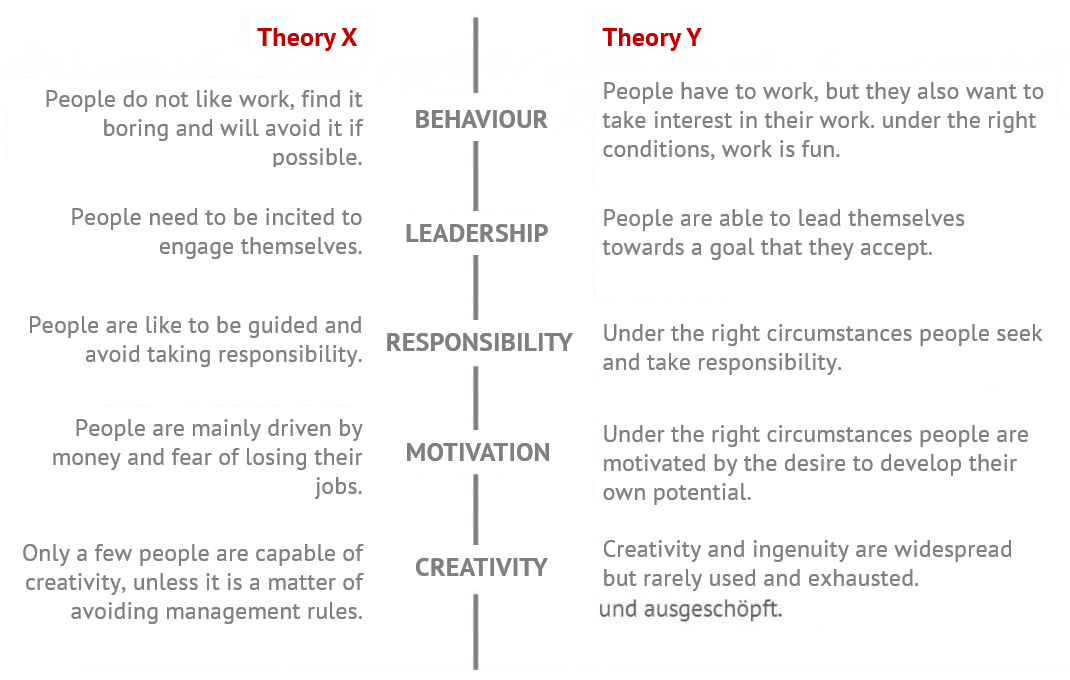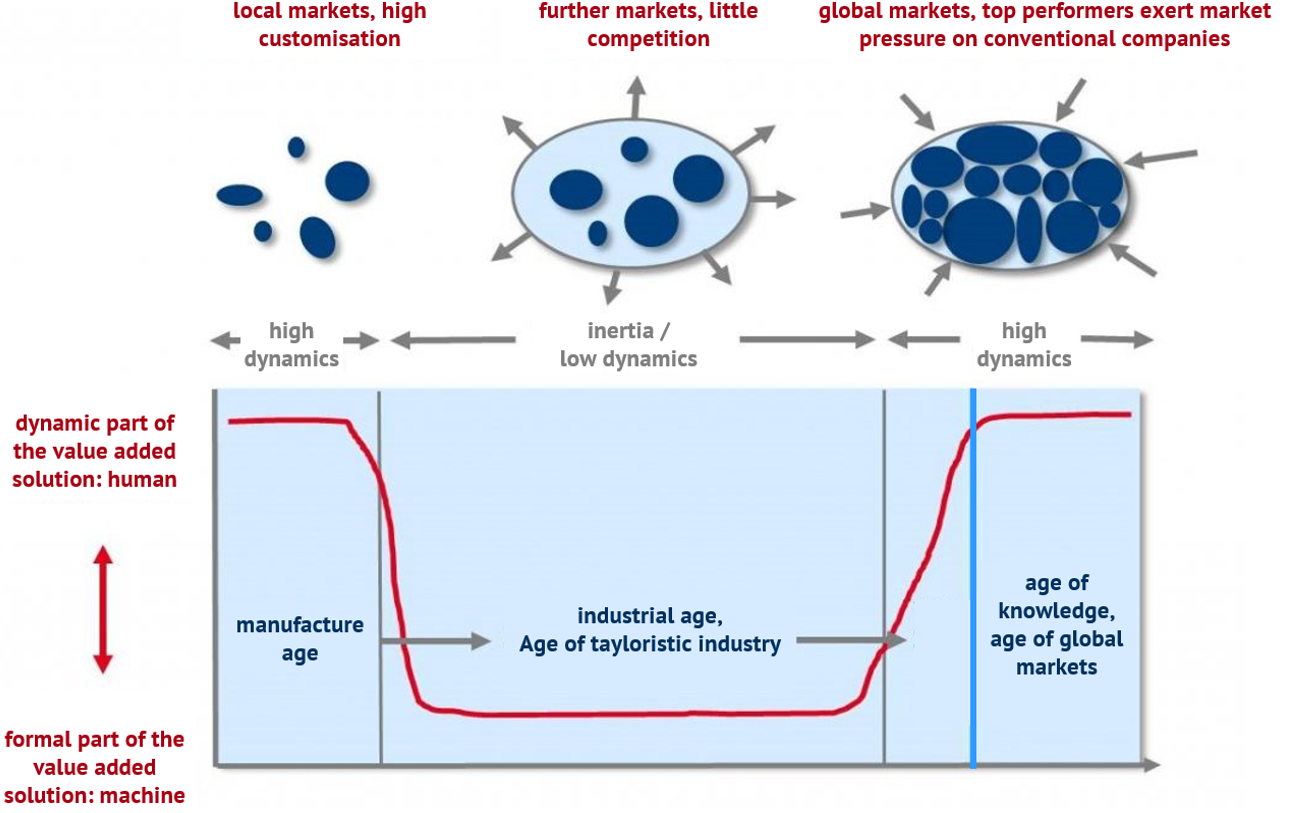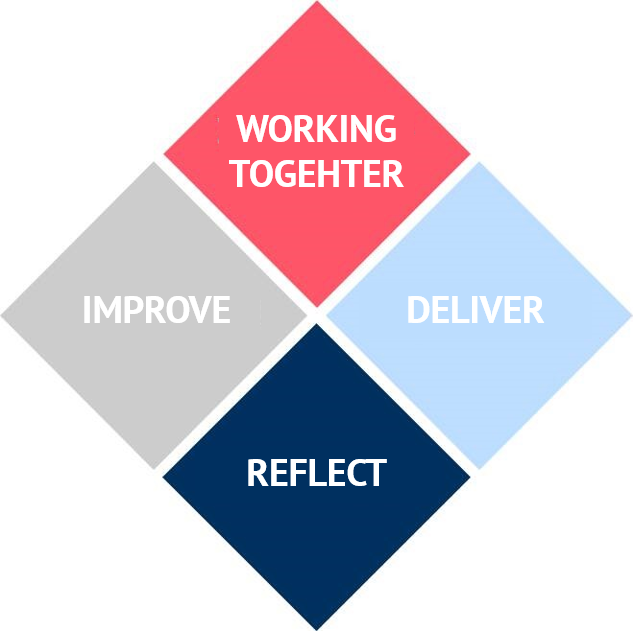The energy industry is overflowing with a lot of trends and buzzwords, such as agile. It is often not easy to distinguish between them: what is hype and what is a sustainable trend for change? However, it is certain that the transformation of energy markets involves more than just the transformation of controllable, fossil-fuel to fluctuating, renewable energy production. It also requires new forms of organisation and leadership.
The whole world is changing in the age of knowledge
It is not only the change in the energy market that is taking place at breathtaking speed and often with great complexity and uncertainty. Our age of knowledge with globalised markets is determined overall by growing dynamics. When we look back in another ten years, the developments of the first 20 years of the new millennium will seem like a snail’s pace. Figure 1 summarises it clearly: high dynamics and complexity are neither good nor bad. They are a historical fact.
In the current Public Utility Study 2019 of the Bundesverband der Energie- und Wasserwirtschaft (bdew), the authors already emphasize in the summary:
“Thus, the supposed chance and opportunity for new business models and sustainable growth can also become a risk, namely when the change towards an agile and innovation-promoting corporate culture is not high on the agenda of energy suppliers.“
But what does “agile corporate culture” mean and why is this agile culture needed today more than ever before? And above all: when and where?
This is a question many people ask themselves today, whether they are managers or employees. However, it cannot be answered generically. For agility is not an end in itself, but a means to an end. Therefore, the question must be extended into several:
- In which areas are we facing complex challenges? Where does self-organisation fit and where does it not?
- Which people work there? Do they have the necessary knowledge, skills and mentality?
- Which methods and tools best support these people in their work?
The first step is to find the right balance between the need for (planning) security and flexibility.
- Where is there a stable environment and where can robust decisions be made with today’s knowledge?
- And where must we react quickly and flexibly to constantly changing situations?
First rule of thumb
This already leads to a first rule of thumb on the topic of agility: where there are complex, that is, complicated and uncertain, challenges, agile methods are superior. In other areas, conventional methods can still be used.
What does building a bridge and designing a website have to do with energy companies?
An example: the construction of a bridge is certainly not without challenges. However, start and finish as well as function are clearly defined and it is not to be expected that these requirements will change fundamentally in the course of construction.
Even though it is not impossible that even better results can be achieved with agile methods, countless structures prove that this task can be successfully solved with conventional processes, project management tools and forms of organisation.
There are also areas in energy companies where work is almost factory like. Here, agile processes are probably not the right answer.
However, it looks fundamentally different when designing a new website. Requirements, goals, functions, design and customer wishes change permanently during the course of the project. The whole process is characterised by uncertainty and complexity. So it is no coincidence that the term agility, as we use it today, originated in software development, first summarised in 2001 in the Agile Manifesto.
The heart of agile
Dr. Alistair Cockburn, one of the Manifesto’s co-authors, reduces the heart of agile to four principles:
- Work closely with others to develop better ideas. Communicate often to facilitate transitions.
- Deliver small test versions first to learn how the world really works. Extend the consignments as you learn to predict and influence the results.
- Reflect regularly along the way. Think about what you have learned in your collaboration and from your consignments.
- Improve the alignment of your ideas, their technical implementation and your internal processes.
From our experience, however, the basis for sustainable success of agile methods is an attitude that goes far beyond this. It questions many common assumptions regarding people, cooperation and motivation.
Why do we have to change our attitude at all?
Both research and experience show that conventional methods of leadership and cooperation often fail when faced with complex challenges. Solving complicated tasks in an unpredictable context requires learning systems and rapid adaptation. This is only possible with self-organisation and people working as autonomously as possible. In many industries and disciplines, the speed factor is so crucial today that companies with conventional, hierarchical processes simply fail.

Fig. 4: Images of people in organisations – comparison of 2 models (Niels Pfläging, Organisation for Complexity vs. McGregor’s Theories)
However, experience also shows that not all people feel comfortable in an agile work environment. This requires a high willingness to reflect on oneself and others.
The success of agile work depends above all on the inner abilities of the employees and their will to learn and develop:
- What motivates them?
- Can they evaluate situations correctly and make appropriate decisions alone or in coordination?
- How resilient are they in crises?
- How well can they communicate in conflicts?
- Are they curious?
It is worth finding out what degree of agility and self-organisation is appropriate for different areas and people. I am sure some of your colleagues will surprise you! Mine have surprised me very much!
Our own experience with agile transformation
Since the beginning of 2019, in just a few months we have jointly transformed Energy Brainpool into an even more dynamic and decentralised company. And we are delighted with the results. Today we work more efficiently and effectively and often with more pleasure.
It is great to see how many colleagues are blossoming in their new, more responsible roles. And our customers are happy to see that they are getting solutions faster that are more in line with their needs.
Of course, the journey was also exhausting and not without conflicts. And in the spirit of agility, the change is now continuing and is not at all complete. But none of us would probably want to go back to the old way.
At Energy Brainpool, as a rule we do not believe in general recipes, but in individual solutions. Every organisation can and must find the right balance between structure and flexibility.
For many companies, individual mixtures of hierarchical and self-organised systems can make sense. However, where we recognise the need for agile working in complex situations, it is necessary to question and adapt the previous organisation and cooperation.
When accompanying the transformation of our clients, we not only draw on our expertise as coaches, agile facilitators and scrum masters, but also bring in our personal experiences from the transformation of Energy Brainpool into a relationship-oriented, dynamic company.
Read here Part 2 of our Series on Agility.
Learn more in our Live-Online-Workshop: Agility in the Energy Market on December 8. & 10, 2020.






